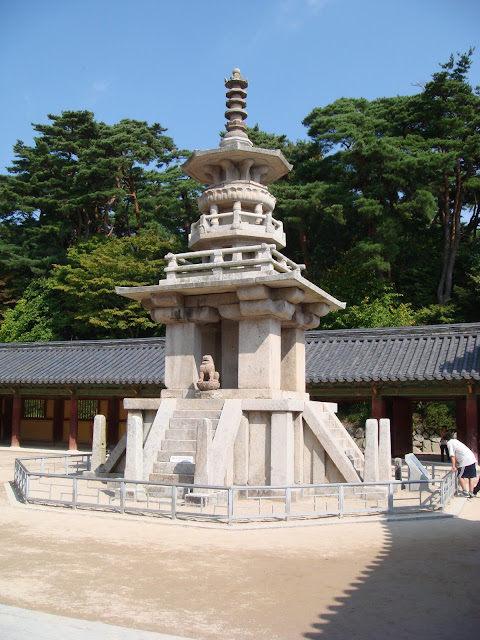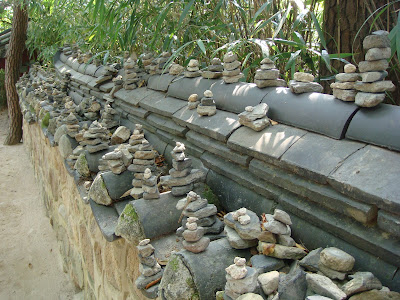Built between 751 and 774 AD, the temple has had a spotty history. It began as an important Silla-period temple, mainly focusing on prayer to protect the country from invasion. Japanese invaders burned it down in 1593, since it had become a headquarters for the local militia. The buildings weren't fully restored until 1969-73, which gives them a strangely inauthentic feel at times.
The bus alights beside a vast car park which contains the ticket office and excellent bathroom facilities should you feel so inclined after almost an hour on a jiggly bus. Then it's a gentle hike up a relatively easy hill for about 15-30 minutes - dependent on how lazily you take it and how often you stop to admire the view.
Entry to Buddhist locations in South Korea always begins with a bridge over flowing water. Water is seen to purify the spirit, so when you step over it you are symbolically leaving the secular world behind you and stepping into the spiritual one. All your worldly concerns are to be left at the door.
The South Korean Government has classified Bulguksa as Historic and Scenic Site No. 1. It isn't especially hard to see why. As well as being an important site for over a thousand years, Bulguksa is set in gorgeous countryside, with terrific landscaping and some of the country's most important Buddhist relics still on-site.
Some treasures survived the temple's razing and can be found within - once you've passed the protective scrutiny of the four guardians in the main gate, that is.
The majority of surviving treasures are built from stone, such as these steps: The lower steps are the Blue Cloud Bridge, and the upper are the White Cloud Bridge. The bridges used to cross a pond which has since dried out.
Buddhist temples in South Korea usually feature four temple instruments: A bell, a drum in the shape of a fish, a cloud-shaped gong, and a more traditional drum. The bell is struck to save the beings of hell; the wooden fish for saving all the beings of the sea; the cloud gong for saving all the beings of the sky; and the dharma drum is to save all the creatures of the earth. All four instruments are beaten both in the morning and evening.
Dabotap is a stone pagoda which dates from approximately 751AD. There were originally four stone lions guarding the stone staircases, but only one remains; the other three have been purloined by parties unknown over the years. The pagoda's construction is unique even to South Korea, and as such is designated National Treasure No. 20, and is featured on the ₩10 coin.
Restoration work has been very thorough and detailed, and gives an excellent idea of how the complex appeared when it was first completed.
Bulguksa is littered with shrines, most of which were reconstructed in the 1970's. The shrine below is of Gwanseeum Bosal, the Bodhisattva of Perfect Compassion.
Behind the Birojeon, a shrine for the Buddha of Enlightenment, are hundreds of hand-built pagodas or stupas. The Buddha of Enlightenment is seen as the Buddha from which all others are created, so it appears that these little constructions are built by those seeking blessings - they aren't mentioned in the handy guide provided at the front gate, and you have to walk around the rear of the building to see them. They vary in size, and are balanced on every available surface.
The temple's bell is massive, and rings out across the mountains and valleys twice a day.
Visiting Bulguksa:
Take bus number 10 or 11 from Gyeongju Intercity or Express Bus Terminals, or Gyeongju Train Station. Alight at Bulguksa Temple after approximately 40 minutes.Admission: ₩4,000. Free audio guide available.













Very nice. I wonder how long it takes them to assign a relative priority to each site?
ReplyDeleteCan you imagine how outraged the Daily Mail would get if anything was placed higher than Princess Di's grave!
That'd go badly!
DeleteSouth Korea has massive lists of cultural treasures, historical sites, and UNESCO heritage sites. How they decided which one tops the list is anyone's guess.